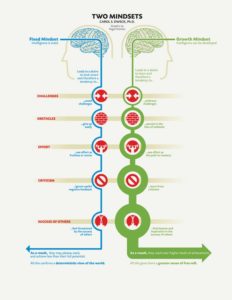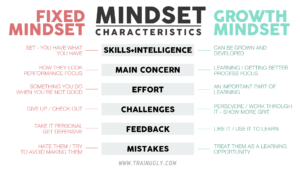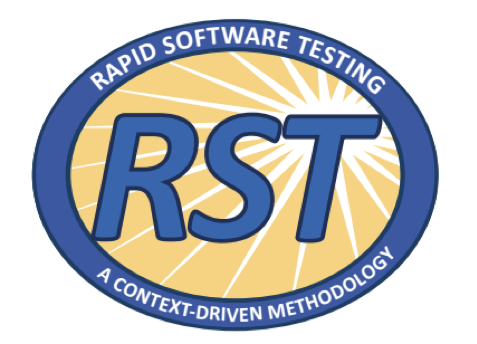This is the last part in a four-part series of blogposts on mindset. In part 1 (Mindset – The book) Nicole and I summarized the book “Mindset”. In part 2 (Looking Back on Perfection and Burnout), we talked about how we suffered from our fixed mindsets. In part 3 (Dealing with mindsets), we shared stories on how we dealt with our mindsets. In this last blogpost we want to help others deal with their own mindset. We share how you can find out what mindset you have and how can you change a fixed mindset into a growth mindset.
We know that mindset is important. A growth mindset is the key to success and more happiness. Or as learner lab taught us “Skills are built, not born.” People are designed to continuously improve! Absolutely everyone has the capacity to be better at virtually everything!
Growth mindset makes you a better and happier person
Research shows that if you have a growth mindset you will be more self-confident, you will allow yourself to make mistakes, you will ask for help more and you will believe it’s okay not to know something. This helps you to be a better learner because you will actually be learning from the feedback and criticism you receive. You also learn to deal with setbacks and you will not give up as easily. This makes you more resilient, will reduce stress and will help to improve relationships because contact is deeper. All of this will make you a better and happier person.
So, what about you? We advise you to learn about mindset. After that, do an introspection to learn about your own mindset. With this knowledge you can deal with your mindset and take steps to change it.
Learn about mindset
First and most important: read the book (or our summary here). The book is easy to read and contains many examples that will give insight in how fixed and growth mindsets work. These visuals also give a bit of understanding about how fixed and growth mindsets work:
There are also many videos you can watch. On the website of Mindset Works you will find a page full of links to amazing videos.
One of the most important things to take away while learning about mindset is simply the fact that traits are not fixed and that you can, in fact, teach an old dog new tricks! We are not born with a finite amount of intelligence, a fixed personality, or a certain amount of artistic talent. Everyone can change and grow – and that opens up a world of possibilities.
Determine Your Mindset
After learning about mindset, it’s time to determine your own mindset. Which mindset do you have? Remember that mindset can differ in different situations. It is perfectly possible that you have a growth mindset in one situation and have a fixed one in other situations. Our mindsets are constantly shifting and changing. There are several tests online you can take to help you gain insight. On the website of Mindset Works, you can find this one. In the book you will find a test too:
Answer these questions about intelligence. Read each statement and decide whether you mostly agree with it or disagree with it.
- Your intelligence is something very basic about you that you can’t change very much.
- You can learn new things, but you can’t really change how intelligent you are.
- No matter how much intelligence you have, you can always change it quite a bit.
- You can always substantially change how intelligent you are.
Questions 1 and 2 are the fixed-mindset questions. Questions 3 and 4 reflect the growth mindset. Which mindset did you agree with more? You can be a mixture, but most people lean toward one or the other. Now look at these statements about personality and character and decide whether you mostly agree or mostly disagree with each one.
- You are a certain kind of person, and there is not much that can be done to really change that.
- No matter what kind of person you are, you can always change substantially.
- You can do things differently, but the important parts of who you are can’t really be changed.
- You can always change basic things about the kind of person you are.”
Here, questions 1 and 3 are the fixed-mindset questions and questions 2 and 4 reflect the growth mindset. Which did you agree with more?
(Source: Carol Dweck. “Mindset – Updated Edition: Changing The Way You think To Fulfil Your Potential)
Changing your mindset
“The key to changing your mindset lies first and foremost in self-awareness”, says Scott Jeffrey of CEOsage, who published a great self-help guide called “A Complete Guide to Changing Your Fixed Mindset into a Growth Mindset“. And we totally agree. We suggest you to begin writing things down on a regular basis, a process called journaling. In this blogpost written by Huib you find more information about reflection and journaling. How do you react in certain situations? What do you feel? What is the inner dialog going on inside your head when a particular situation arises? Write down your observations. It helped us to recognize patterns and feelings.
In our experience after finding out about the importance and influence of mindset, we dealt with our mindsets better. Also learning about neuroplasticity made us see that there is a way to change our mindsets. It is important to do an introspective to find out in which situations your mindset is fixed and not helping you. It opens up possibilities to change and grow.
Step 1: in the book Dweck advises us to accept that we all have both mindsets. The first step is to recognize and embrace your fixed mindset.
Dweck suggests to give the persona a name. And we think it is actually a good idea we had never thought of. Huib named his fixed mindset “Randall Flagg” after the villain from Stephen King’s book. Also as a pun to flag when his fixed mindset pops up. Nicole named hers “Marie”, which is her middle name. It helps remind her that her fixed mindset is always there, waiting to appear.
Step 2 is to learn what triggers our fixed mindset. Failures? Criticism? Deadlines? Disagreements? When is your fixed mindset a problem? Understand what happens to you when your persona shows up. Learn about yourself, your feelings and the fears that activate it. As you come to understand your triggers and get to know your fixed mindset persona, don’t judge it. Just observe it.
Step 3 is to recognize that you have a choice. Remind yourself that it is “just” fear. Your beliefs and your thinking are sabotaging your growth and giving you stress. When you recognize your fixed mindset, remember it is just a mindset. And mindsets can change. Accepting your fear will make it easier to deal with it.
Your brain can change due to neuroplasticity. Neuroplasticity is the ability of the brain to undergo changes. Research shows that many aspects of the brain can be altered (plasticity means changeable) even through adulthood! Actually, our brain is built to change. By practicing, you can change the pathways in your brain. Watch this video or read this article to learn more.
Step 4: the last step is to switch to a growth mindset when those triggers occur. Here it is key to understand that it is all about how you think. Your belief is the most important factor. Focus on what you learned about mindsets. Hold the belief that you can change your mindset. Learner lab taught us: to build a growth mindset, focus on the belief, and the actions will follow. Challenge the fixed mindset persona by asking questions to guide your thoughts. Open yourself up to growth. Take small steps. Don’t expect too much and realize it will take time and effort to change your mindset. Experiment and try different approaches. Find a way that suits you.
Scott Jeffrey made a great list of questions that might help you activate a growth mindset:
- What can I learn from this?
- What steps can I take to help me succeed?
- Do I know the outcome or goal I’m after?
- What information can I gather? And from where?
- Where can I get constructive feedback?
- If I had a plan to be successful at [blank], what might it look like?
- When will I follow through on my plan?
- Where will I follow through on my plan?
- How will I follow through on my plan?
- What did I learn today?
- What mistake did I make that taught me something?
- Is my current learning strategy working? If not, how can I change it?
- What did I try hard at today?
- What habits must I develop to continue the gains I’ve achieved?
When you are facing a problem or situation that you are trying to apply a growth mindset solution to, Dweck suggests to make a concrete plan: “These concrete plans (plans you can visualize about when, where, and how you are going to do something) lead to really high levels of follow-through, which, of course, ups the chances of success.” Once you have that plan, stick to it.
Change is hard
Remember that change is hard. We make changing your mindset sound easy on paper but like any other change, it is a journey. It doesn’t happen overnight. You will have setbacks. The key is to approach these setbacks using your growth mindset: what can you learn from them? What will you change the next time you are in the same situation? Adjust your growth plan as needed. You will also have successes. Learn from them as well! What can you take away from them to continue to grow? Keeping setting goals for growth. If one approach doesn’t seem to work, readjust and try another.
Keep at it. As Dweck says, “Mindset change is not about picking up a few pointers here and there. It’s about seeing things in a new way.” Keep taking the growth-oriented action. Eventually with time and repetition, it becomes habit. Changing your mindset takes effort, but it will open up all sorts of doors to new opportunities.
We love to hear from you
Good luck working on your mindset. We are curious to learn how it goes for you. If you want to share your stories, need some help or just want to talk, let us know. We are happy to talk to you! Find us on Twitter (Huib and Nicole) or LinkedIn (Huib and Nicole). Start today, don’t think it will get better by itself. Because it won’t. It requires work. A lot of work. But it will make your life a whole lot easier. If you need some support in your journey, just reach out.
Resources:
- Mindset – Changing the way you think to fulfil your potential by Professor dr. Carol Dweck
- Learner lab: Growth Mindset – what it is, why it matters, how to build one within yourself and others
https://thelearnerlab.com/growth-mindset/ - Learner lab: Neuroplasticity – Our Brain is Like a Muscle
https://thelearnerlab.com/neuroplasticity-our-brain-is-like-a-muscle/ - Scott Jeffrey (CEO Sage): A Complete Guide to Changing Your Fixed Mindset into a Growth Mindset
https://scottjeffrey.com/change-your-fixed-mindset/ - Mindset Works: Video Library
https://www.mindsetworks.com/Videos - The art of reflection
https://www.huibschoots.nl/wordpress/?p=2824






0 Comments
1 Pingback